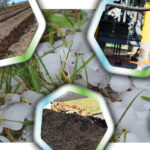
Nora Goldstein
BioCycle July 2014
The lead paragraph in an article titled, “Rt. 33 interchange on track for November finish” in our local newspaper last Saturday read as follows: “Right now, it’s just mounds of dirt, construction trucks and rows of cornfields. But soon, a stretch of farmland in Palmer Township will be transformed into a commercial corridor with monster warehouses, office space and hubs of restaurants, hotels and retail shopping.”
Despite the 5,000 jobs the development is said to eventually generate, and the millions of dollars in tax revenue that will be filling the coffers of the township, county and school district, reading this article made me shudder. Our area of Pennsylvania, known as the Lehigh Valley, was filled with prime, productive farmland at one time. Gradually, over the past 50 years, much of the farmland has been developed into tract housing, malls and major interstate highways that connect us with the Philadelphia and New York City metropolitan areas. Those interstates have attracted distribution businesses in need of easy access to roads. Those businesses, in turn, need the monster warehouses (acres and acres in size) mentioned above. The warehouses, in turn, need thousands of tractor-trailers to bring the goods in and out.
From a traditional economic development perspective, this is an all-around win in terms of jobs and tax revenue. From an environmental perspective — especially in terms of climate change — this is a nightmare! When prime farmland is paved, not only is precious topsoil lost, but so is soil’s role in sequestering carbon, infiltrating storm water and recharging groundwater, and growing local food. In the newspaper article, Don Cunningham, president and CEO of the Lehigh Valley Economic Development Corp., said that the interchange is “expected to lure more businesses.” The next sentence? “And what was once green and pastoral will become paved and bustling with the movement of products.”
That movement of products will happen with diesel-fueled trucks. The primary way people will be able to get to work, shop and/or eat is to drive their cars, as this region sorely lacks public transit. In short, this latest economic development “wonder” in the Lehigh Valley is anything but sustainable.
But it’s not too late to get this right. As you will read in our July 2014 cover story, “State of Composting in the U.S.”, local officials in other regions are requiring green infrastructure best management practices (BMPs) that use compost in postconstruction soils to ensure infiltration of storm water and reduce runoff of nitrogen and phosphorus from lawns. And both composting and compost use — such as in green infrastructure — create local, sustainable jobs (have a look at the job creation tables in the article).
Unfortunately, developments like these in the Lehigh Valley have too much political and private sector support to stop this particular one in its tracks. So how can this new commercial corridor in the Lehigh Valley do it better? Here’s an initial list: 1) Require a minimum 5 percent organic matter in soils after construction, and utilize compost-based BMPs such as bioretention ponds for storm water management; 2) Build the warehouses to support installation of green roofs (all the warehouses in the Lehigh Valley have flat roofs); 3) Install an anaerobic digester to process source separated organics from the cafeterias, restaurants, convenience stores, etc., and utilize the biogas to make compressed renewable fuel for the trucks; 4) Compost the digestate with other source separated organics from the development.
None of those steps is difficult to take. All the tools/equipment and know-how necessary to make it happen are available. Instead of being a follower in the same-old style of economic development, the Lehigh Valley could be a leader and innovator. Let’s help them get this right.









